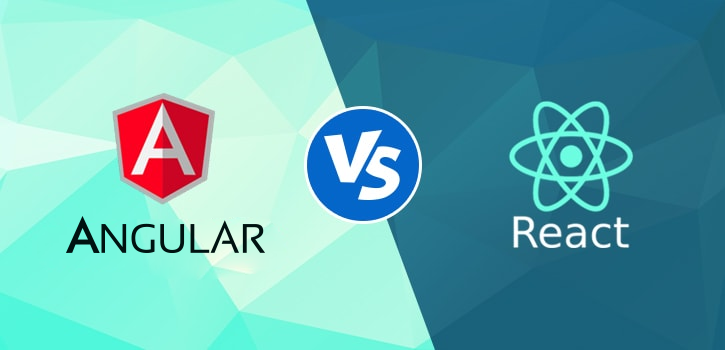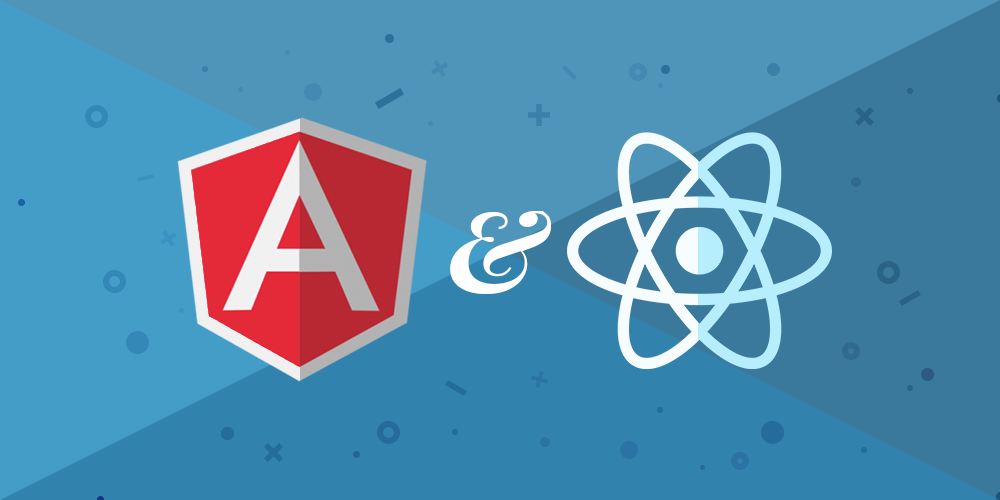React vs Angular: What Will Be Better For Your Front-end?

Web programming underwent a lot of changes in the past few years. Earlier, multiple packages such as PHP, Tomcat, Apache, and Java were essential to develop complex internet pages. But with the inception of Angular and React Javascript frameworks, it is possible to merge systems or programming languages with a front end framework. As per Statista, 35.9% (approx.) users preferred ReactJS for their front end development. But 16.1% (approx.) users chose Angular in the year 2020.
But choosing the best from these two can be a tough task, and that is why React vs Angular became a popular debate in the IT world. Many of our clients ask us to suggest the best frontend framework. In this blog, we will try to answer this question by providing you with in-depth information on these frameworks.
Factors that differentiate React and Angular
The major difference between both these technologies is that Angular is a JavaScript framework, while React is a Javascript library. Despite that, there are some other factors that can differentiate React from Angular:
1. Performance
Before you start with web development, you need to consider the performance of your selected technology. React uses virtual DOM, while Angular uses the regular DOM. But to get a better understanding of React and Angular’s performance, you need to understand the meaning of DOM first.
DOM (Document Object Model) is an abstract Application Programming Interface that depicts the parts of an HTML document as a tree. Each of these parts contains an object and node. DOM also allows programs to access the information quickly from the document that is necessary to run the app.
Talking about the differentiation in performance, Angular uses a virtual DOM that makes the process faster by just changing the updated parts of the tree. While React uses the regular DOM that updates the entire tree whenever a user makes any change in the document. In this way, speed can be one of the important points of differentiation between React and Angular.
2. Ability to maintain codes
Angular is a popular framework to make single-page applications that contain complex structures and multiple programming modules. It is a strong framework that can support such complex maintainability and can manage complicated naming conventions.
Sometimes, developers may have to deal with serious maintainability problems while building rich web clients, where combining HTML and Javascript is difficult because of less modularization. But Angular resolves these problems by building maintainable JavaScript and an HTML extension to deal with such problems. This can save a good amount of time for developers.
React can be the best way to write clean code from scratch without slowing down the production. It does not allow developers to write the codes separately that makes it intelligible for other developers. Apart from this, React also facilitates the reusability of code by allowing the means to create reusable UI components.
In this way, React allows creating custom components that easily render the uncontrolled input fields and recognize the components with unique naming conventions.

3. Server-Side Rendering
Angular makes it possible for web crawlers to generate a static version of apps that are likeable and easy to search. With server-side rendering, Angular renders the static view of an app before it becomes interactive. Apart from this, Angular is also good at reducing the traffic between the server and the client.
To make an SEO-friendly app, render the app to the server. React can easily do this with its ‘ReactToString’ function. Alternatively, you can also use ‘renderToStaticMarkup’ if you want to avoid creating DOM attributes such as data-react-id, which is used to make a simple static page generator.
4. Use Cases
React and Angular have significantly contributed to making apps that are popular across the entire world. Angular is a development platform that is used to develop single-page applications. While React used to make robust user interfaces and reusable UI components.
Angular is well known for its model view controller capability that increases the functionalities of browser-based application development. And React is useful for large-scale apps to load the data without refreshing.
Netflix, Instagram, WhatsApp, Dropbox, Pinterest, etc. are some of the popular use cases of ReactJS. While Gmail, Forbes, Upwork, PayPal, JetBlue are some applications of Angular.
5. Scalability
For scalability, both React and Angular are the best front end frameworks as they equally empower high traffic web apps used by the tech giants.
The reason behind this popularity is that React’s library depends on the virtual DOM. With virtual DOM, you can develop your projects with great speed as it incorporates the updates faster.
On the other hand, Angular contains a logical structure of Typescript that is a substitute for coding in pure Javascript. With Typescript, developers can be able to compile the version of Javascript that works on every web browser.
6. Data Binding
Angular uses two-way data binding that keeps the two layers updated with the same data. It binds the HTML element to the model variable and makes necessary changes to the backend. This helps the programmer to create an excellent user interface with minimal efforts.
However, React does not follow the automatic approach to data binding and sticks to its simplest but solid architecture. It does not let developers fall into the nitty-gritty of complex object handling. React uses one-way data binding to help the developers to manage both heavy parsing work and extensive data manipulation.
7. Learning Capabilities
Angular is a dynamic framework. So if somebody wants to develop a project with Angular, then they first need to learn a lot of things such as modules, decorators, components, services, dependency injections, and templates. Initially, Angular demanded higher learning capabilities compared to React. But Angular becomes the frontrunner in solving the complicated issues of large-scale applications.
Managing internal states, writing components, and usage of props are the primary things to learn at the time of React development. Developers find it much easier to work on React as they do not need to learn complex logical structures.
8. Testing
Testing user interface components involves rendering in a sandbox environment, simulation of user interaction, and validation of the output. We can simplify these routine tasks with the appropriate test assistant. For Angular, this is the built-in TestBed and for React it is the Enzyme and Testing Library.
Enzyme allows components to be displayed in full or shallow DOM, as well as interact with the rendered component. It follows a white-box testing approach where your tests can reference some of the internal components of a component.
Testing Library takes a novel approach and pushes you to interact with your components like a user would, without knowing the technical implementation. Tests created in this way are usually less fragile and easier to maintain. Although it is the most popular in React, this tool is also available for Angular.
Conclusion
The choice of the best front-end framework depends on your business goals and requirements. So, if you are a beginner or if you want stability in your project, then you should hire React developers because their learning curve is fast and the React job market is higher than Angular. But if you are looking for a full-fledged framework to build a large scale project along with a straightforward coding strategy, then you should hire Angular developers.
If you think that front end development is not your cup of tea, then you can hire offshore remote development team or you can extend dedicated development team. A front end developer or a development team will update you with the latest development trends in the market. Also, they will show you the best ways to reduce your front end development cost.
Hope you liked this blog. Reach out to us, if you have any question in your mind regarding front end development.





